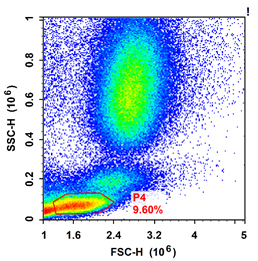Procedures and precautions for the preparation of human peripheral blood monocyte suspensions
Human peripheral blood single cell suspension preparation procedure
1. Collect human peripheral blood samples in an anticoagulation tube. 2.
2. Add 100 μL of fresh blood and 2 mL of 1× erythrocyte lysate into the centrifuge tube, mix well, and lysed at 4℃ for 10 min. 3.
3. Centrifuge at 300 g for 5 min (centrifuge immediately after lysis to prevent prolonged damage to the cells), discard the supernatant, and obtain white cell precipitate.
4. Wash with PBS once.
5. Add 100 μL of cell staining buffer to resuspend the cells, without counting, and then proceed to the subsequent flow antibody staining experiments. Add 1 Test of the corresponding flow antibody to 100 μL of single-cell suspension prepared from fresh blood samples and mix well for subsequent experiments.
Human peripheral blood FSC/SSC map



Precautions:
1. Anticoagulation tubes for blood collection are available in heparin and EDTA. If the red blood cells are lysed directly for surface indicator staining experiments, both anticoagulation tubes can be used; if the blood is collected for cytokine detection, heparin anticoagulation must be used.
2. 10× ACK Lysis Buffer (E-CK-A105) without fixative is recommended for lysis solution.
3. 10× ACK Lysis Buffer needs to be diluted into 1× with pure water before the experiment, ready for use, recommended to be placed in 4℃ for temporary storage and used on the same day.
4. For the detection of routine indicators in human peripheral blood, overnight stored samples can be used, which is generally not a big problem. However, for indicators with low expression, it is recommended to use fresh samples.
5. When centrifuging and discarding the supernatant after the third step of lysis, it is recommended to use a pipette gun to gently suck away the residual liquid. If poured out directly, there will be residual lysate in the centrifuge tube, and when 100 μL of PBS is added to resuspend the cells, the lysate may not be completely diluted, resulting in excessive lysis of erythrocytes.
6. To resuspend the cell precipitate, gently blow with a gun or vortex with a vortexer with a small rotation speed.
7. Human blood samples are recommended to be stained with CD45, which facilitates circle gating during subsequent data analysis.
8. When processing human blood samples, it is recommended to set up a single tube stained only with CD45 at a low speed for setting thresholds, observing cell volume and circling lymphocyte populations.
9. Human peripheral blood contains mainly T-lymphocytes, and the amount of B-lymphocytes is small. If a patient's blood sample is used, the amount of B-lymphocytes may be even lower. Therefore, it is not recommended to use overnight samples for B-lymphocyte assay, as overnight samples tend to result in low detection signal.
For more information, visit our website: www.aladdinsci.com.
